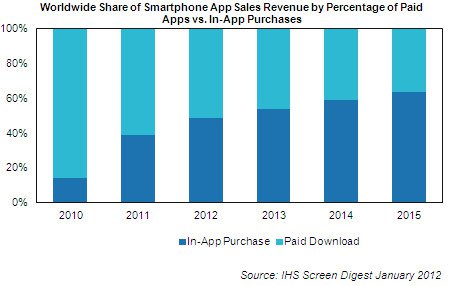Is freemium the answer to making apps pay?

Monetising paid apps is getting harder - but in-app purchases are on the rise, says analyst...
Ask any mobile developer: getting smartphone users to pay for apps isn't easy - and it's only going to get harder, according to analyst IHS Screen Digest. Developers need to turn their attention to making money from in-app purchases, which it said are on the rise.
The analyst said the freemium business model, where apps are free at the point of download but charge a fee for new content, will soon be the dominate smartphone apps business model.
IHS Screen Digest reckons in-app purchases will rise to account for well over half (64 per cent) of total app market revenue in 2015, up from just over a third (39 per cent) last year, while revenue from in-app purchases will swell to $5.6bn in 2015, up from $970m in 2011. The data comes from its Mobile Media Intelligence Service.

Paid apps vs in-app purchasesImage: IHS Screen Digest
"Smartphone users overwhelmingly prefer free apps to paid apps, as we estimate 96 per cent of all smartphone apps were downloaded for free in 2011," said Jack Kent, senior analyst, mobile media for IHS, in a statement.
"In 2012, it will become increasingly difficult for app stores and developers to justify charging an upfront fee for their products when faced with competition from a plethora of free content. Instead, the apps industry must fully embrace the freemium model and monetise content through in-app purchases."
By the end of the third quarter of 2011, free-to-download apps already represented close to half (45 per cent) of the top-grossing US iPhone apps, according to IHS Screen Digest, as well as almost a third (31 per cent) of the highest-earning US Android Market apps. The analyst calculates that a substantial majority (68 per cent) of the top-grossing US apps featured some form of additional content or functionality unlocked by an in-app purchase.
While games have pioneered the in-app payment model - with virtual currencies such as poker chips accounting for the largest proportion (63 per cent) of in-app purchases on the US iPhone App Store at the end of the third quarter of 2011 - the analyst said the approach has been so successful that companies building other types of apps need to get involved to "to maximise their mobile app revenues".
The next most popular in-app purchase after virtual currency was for specific in-game function or features, accounting for around a fifth (22 per cent) of the most popular US in-app sales. Other popular buys include time-limited navigation services, dating and premium social network access, plus specific functions or features for photo and video apps.
Just two per cent of the top US in-app purchases were for additional media content such as TV or video content. Time-limited subscriptions or in-app purchases to newspaper/magazine content was more successful - in the UK such media in-app buys accounted for five per cent of the top iPhone in-app purchases during the third quarter of last year.
In related app news, professional services firm Deloitte predicts that as the supply of global apps continues to grow the number of paid downloads - and indeed app downloads generally - is likely to shrink. But writing in its Technology, Media and Telecommunications Predictions 2012 report, the company says this does not mean the app model is fundamentally flawed - but rather reflects the "winner-takes-all" nature of much online content.
As competition between increasing numbers of apps intensifies, countries with more mature app ecosystems are expected to see production and marketing costs for apps escalate. Deloitte even predicts the most expensive apps produced this year could cost millions of dollars.
It's not just getting your app noticed that's going to get harder, either - developing apps is going to become increasingly complex as the app and device landscape becomes more diverse, predicts Deloitte.
"In the future, the global apps market is likely be characterised by the co-existence of multiple platforms, countries, languages, genres, manufactures, file sizes and even model-specific application stores. To reach more than 90 per cent of all app users, a developer may need to create versions for five different operating systems (plus HTML5), five major languages, three different processor speeds, and four different screen sizes. In other words 360 variants of a single app may be needed to be created in order to fully cover the global market," the report said.
Deloitte also predicts the feature and capability gap between top of the range smartphones and more budget $100 or less devices will widen this year - adding to the number of versions of apps developers need to make.
"In 2012, the fastest smartphones will likely offer quad-core 1.5-2.5GHz processors while the growing numbers of $100 smartphones is likely to have processors with speeds between 200MHz and 600MHz," it said.